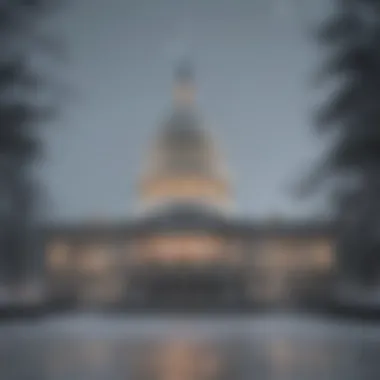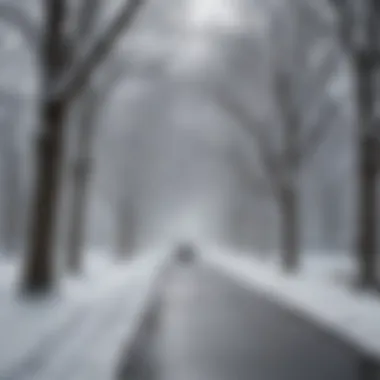Unveiling the Profound Impact of Snow in Washington, DC


Skateboarding News Updates
Weather Patterns and Snowfall Trends
In Washington, DC, the impact of snowfall on the city's weather patterns cannot be overlooked. Snowstorms affect the region, with varying intensity and duration, significantly altering daily life and transportation systems. The city's response to winter conditions plays a pivotal role in managing snow-related challenges and ensuring the safety of residents.
Effects on Daily Life
Snow in Washington, DC disrupts the normal flow of daily activities, leading to school closures, work disruptions, and transportation delays. Residents are required to adapt to changing weather conditions, emphasizing the need for preparedness and resilience in the face of winter challenges.
Trick Tutorials and Guides
Navigating Snowy Terrain: Expert Tips
Traversing snow-covered landscapes requires a unique set of skills and techniques. From understanding the consistency of snow for effective movement to mastering balance in slippery conditions, exploring snow's impact on skateboarding opens up a realm of new possibilities for riders seeking to push their limits.
Winter Skateboarding Gear Essentials
Investing in appropriate winter skateboarding gear is essential for optimizing performance and safety. From specialized snow skateboards to insulated protective clothing, gearing up for cold weather conditions can enhance the skateboarding experience and minimize risks associated with snow-related obstacles.
Snow Adaptation Training
Training for snow skateboarding involves adapting traditional skateboarding maneuvers to winter landscapes. From practicing controlled slides in icy conditions to learning how to land tricks on snow-covered ramps, mastering snow skateboarding techniques requires dedication, focus, and a willingness to explore new avenues of the sport.
Skateboarding Culture and Lifestyle
Embracing Seasonal Challenges: Community Perspectives
In Washington, DC's skateboarding community, snow presents both a challenge and an opportunity for creativity. Embracing winter conditions fosters camaraderie among skateboarders, with shared experiences of tackling snow-covered skate parks, experimenting with innovative tricks in the snow, and celebrating the resilience of the skateboarding culture in the face of seasonal obstacles.
Snowboarding Crossovers and Collaborations


Exploring the intersection between snowboarding and skateboarding unveils a realm of creativity and collaboration. From snowboarders testing their skills on skateboards to skateboarders incorporating snowboarding techniques into their repertoire, the synergy between the two disciplines transcends seasonal boundaries and inspires cross-disciplinary exploration.
Gear Reviews and Recommendations
Snow Skateboard Deck Analysis
Choosing the right snow skateboard deck is crucial for optimizing performance on icy terrain. Factors such as deck width, concave shape, and material durability play a significant role in determining how well the board handles snow-covered surfaces, providing riders with stability, control, and maneuverability in challenging winter conditions.
Winter Wheel Configurations
Selecting appropriate winter wheels for snow skateboarding involves considering factors such as wheel diameter, durometer rating, and tread design. Customizing wheel configurations for snowy terrains can enhance grip, traction, and overall board control, enabling riders to navigate icy surfaces with confidence and precision.
Insulated Protective Gear Selection
Prioritizing insulation and protection in winter skateboarding gear is essential for safeguarding against cold temperatures and potential injuries. From padded clothing and impact-resistant helmets to thermal layers and moisture-wicking accessories, investing in high-quality protective gear ensures optimal comfort and safety during snow skateboarding sessions.
Healthy Lifestyle for Skaters
Cold Weather Warm-Up Routines
Engaging in dynamic warm-up routines is crucial for preparing the body for winter skateboarding sessions. Incorporating stretching exercises, joint mobility drills, and cardiovascular warm-ups helps prevent cold-related injuries, enhances muscle flexibility, and improves overall performance in snow skateboarding activities.
Snow Skateboard Fitness Regimens
Maintaining physical fitness and strength is key to excelling in snow skateboarding. Implementing workout routines that target core stability, lower body strength, and cardiovascular endurance enhances agility, balance, and power, improving overall athletic performance and reducing the risk of injuries in winter skateboarding endeavors.
Nutrition Strategies for Cold-Weather Skateboarding
Fueling the body with proper nutrition is integral to sustaining energy levels and maximizing performance in snow skateboarding. Incorporating a balanced diet rich in complex carbohydrates, lean proteins, and healthy fats supports muscle recovery, mental acuity, and immune function, optimizing athletic achievements and resilience in challenging winter conditions.
Introduction


The exploration of the impact of snow in Washington, DC is a multidimensional and intricate endeavor that unveils the profound influence that snowfall exerts on the local environment and the community. Snow, beyond its aesthetic charm, acts as a transformative agent, significantly altering weather patterns, daily routines, and societal dynamics within the capital city. Understanding the implications of snow in this unique urban setting not only provides valuable insights into meteorological phenomena but also sheds light on the resilience and adaptability of the residents in the face of winter adversities. Throughout this article, we will dissect the various facets of snowfall in Washington, DC, ranging from its historical significance to its contemporary repercussions, offering a detailed examination of how this natural phenomenon shapes and molds the fabric of the city. By delineating the intricate connections between snow and Washington, DC, we aim to unravel the complexities and nuances of this elemental interaction, underscoring the city's intricate dance with winter's frozen embrace.
Historical Context
Snowfall holds a vital place in the historical context of Washington, DC, serving as a significant element that has shaped the city's identity and functioning. Over the years, snowfall trends have not only impacted the local climate but also influenced various aspects of societal life and governance in the region. Understanding historical snowfall patterns is crucial for comprehending the city's resilience and adaptability in the face of winter challenges.
Snowfall Trends over the Years
Analyzing snowfall trends over the years provides valuable insights into how the frequency and intensity of snow events have evolved in Washington, DC. By examining historical data on snow accumulation and distribution, we can discern patterns that shed light on climate variability and change. These trends offer a glimpse into the city's vulnerability to extreme weather conditions and highlight the importance of proactive measures in managing winter phenomena effectively.
Memorable Snowstorms in 's History
Exploring memorable snowstorms in DC's history unveils the enduring impact of extreme winter events on the city and its inhabitants. By recounting significant snowstorms that have left a mark on the collective memory of the community, we gain a deeper appreciation for the resilience and solidarity exhibited during times of crisis. These historical snowstorms serve as poignant reminders of the unpredictable nature of weather and the necessity of robust disaster preparedness strategies.
Meteorological Factors
When delving into the impact of snow in Washington, DC, it is imperative to analyze the meteorological factors that contribute to the city's winter conditions. Understanding these elements provides a fundamental insight into the snowfall patterns and the extent of their impact on the local environment and populace. Meteorological factors play a pivotal role in shaping the dynamics of snow events, influencing everything from the intensity of snowfall to the duration of winter storms.
Atlantic Weather Systems significantly influence the snowfall trends in Washington, DC. The city's proximity to the Atlantic Ocean exposes it to weather systems originating from the east coast. These systems bring moist air inland, which interacts with cold air masses, resulting in the formation of snowstorms. The interaction between Atlantic weather systems and local atmospheric conditions creates the ideal environment for substantial snow accumulation in the region.
Topographical features play a crucial role in determining snowfall patterns in Washington, DC. The city's diverse landscape, characterized by varying elevations and terrain types, influences how snow is distributed across different areas. Areas at higher altitudes tend to receive heavier snowfall due to orographic lifting, where air is forced to rise over elevated terrain, leading to enhanced precipitation. Conversely, lower-lying areas may experience less snow accumulation due to the sheltering effect of hills and mountains.
Societal Impact
In the realm of scrutinizing the imprint of snow in Washington, DC, the societal impact stands as a pivotal dimension requiring meticulous exploration. The ramifications of snowfall cascade across various elements of communal subsistence, touching upon transportation disruptions, economic repercussions, and community readiness processes. Snow, as a meteorological entity, not only alters the physical landscape but also engenders a ripple effect on the daily interactions and functioning of the denizens dwelling in the capital region.
Transport Disruptions and Infrastructure Challenges
Delving into the intricacies of transport disruptions and infrastructure challenges unveils a tapestry woven with complexities. As snow descends upon the city, the well-oiled machinery of transportation grinds to a halt, grappling with icy roads and snow-packed thoroughfares. Public transportation systems strain under the weight of inclement weather, leading to delays, cancellations, and a palpable sense of disarray. The built environment, intricately meshed with the urban fabric, confronts challenges in maintaining functionality amidst snow accumulation, demanding swift action and strategic planning to mitigate disruptions.
Economic Consequences of Snowstorms


Unpacking the economic consequences entwined with snowstorms in Washington, DC unfurls a narrative of fiscal ebbs and flows. Businesses, ranging from small enterprises to corporate entities, navigate a tumultuous terrain as snow blankets the city, disrupting normal operations and consumer footfall. The economic pulse of the region bears the brunt of reduced productivity, increased operational costs, and potential revenue losses, fostering an environment where financial resilience transforms into a beacon of survival. Navigating the economic aftermath of snowstorms necessitates astute financial planning, adaptive strategies, and a keen eye for capitalizing on opportunities emerging amidst the frosty backdrop.
Community Responses and Preparedness
The fabric of community responses and preparedness emerges as a critical thread interwoven into the snowy tapestry of Washington, DC. Residents, businesses, and local authorities stand at the forefront of navigating through the challenges posed by snowfall, necessitating a collective effort rooted in resilience and adaptability. From snow-clearing initiatives to emergency response protocols, the community's preparedness plays a pivotal role in safeguarding lives, ensuring essential services continuity, and fostering a sense of solidarity amidst the winter's chill. Community engagement, proactive measures, and informative campaigns constitute pillars supporting the edifice of resilience in the face of snow-related adversities.
Governmental Response
Snow Removal Strategies and Prioritization
Within the domain of governmental intervention, Snow Removal Strategies and Prioritization occupy a central position in fortifying the city's resilience against snowfall disruptions. This subcategory delves into the meticulous planning and allocation of resources aimed at clearing snow-laden streets, highways, and public spaces. Through a detailed elucidation of various snow removal methodologies employed, ranging from plowing to salting, we aim to showcase the ingenuity and efficiency underpinning DC's snow management apparatus. Furthermore, an analysis of prioritization criteria based on factors like traffic volume, emergency routes, and neighborhood density will shed light on the nuanced decision-making processes that ensure swift and effective snow clearance operations.
Communication and Public Safety Measures
An integral aspect intertwined with governmental response pertains to Communication and Public Safety Measures enacted during snowfall incidences. This section unveils the intricate web of communication channels utilized by authorities to disseminate crucial information, ranging from weather forecasts to road closures, thereby enabling informed decision-making among residents. Moreover, a deep dive into public safety protocols, encompassing emergency response strategies and shelter provisions, will underscore the paramount importance accorded to protecting lives and minimizing risks during snow emergencies. By unraveling the intricacies of communication and safety measures, we aim to accentuate the collaborative efforts that underpin DC's resilience in the face of wintry adversities.
Cultural Perspectives
In the exploration of the impact of snow in Washington, DC, delving into cultural perspectives unveils a rich tapestry of traditions and beliefs intertwined with winter phenomena. Cultural perspectives serve as a lens through which the city's inhabitants navigate the snowy landscapes, reflecting their heritage, values, and interconnectedness with the environment. Understanding these perspectives provides valuable insights into how communities adapt and evolve in the face of changing weather patterns and seasonal challenges. By examining the cultural significance of snow in DC, we unravel a deeper narrative of appreciation for nature's rhythms and human resilience amidst winter's embrace.
Winter Rituals and Traditions in
Winter rituals and traditions in DC encapsulate a blend of historical practices and contemporary celebrations that illuminate the city's cultural soul during snowy seasons. From annual festivals honoring snow deities to modern-day gatherings that showcase the artistry of ice sculptures, these rituals serve as a testament to the enduring spirit of the community in embracing winter's beauty. Families huddled around crackling fires, sharing stories of blizzards past, instill a sense of continuity and belonging, connecting generations through shared experiences of snow-covered landscapes. Exploring these rituals sheds light on the intimate relationship between residents and the winter environment, grounding the city's identity in a tapestry of snowy traditions.
Artistic Representations of Snow in
Artistic representations of snow in DC serve as vibrant reflections of how the city's creative pulse responds to winter's icy touch. Through paintings capturing the ethereal beauty of snowflakes to sculptures that evoke the stillness of a snow-covered park, artists in DC channel the essence of winter into captivating works of art. These representations not only showcase the visual allure of snow but also provide poignant commentary on themes of resilience, transformation, and the passage of time. By analyzing these artistic expressions, we gain a deeper appreciation for how snow transforms the urban landscape into a canvas of inspiration, inviting both contemplation and celebration amidst the frosty chill.
Conclusion
In this definitive account of the impact of snow in Washington, DC, the conclusion serves as the summation of our exploration into the profound implications of snowfall on this historic city. Here, we distill the essence of our findings, highlighting the intricate ways in which snow permeates the fabric of DC life.
Delving into the conclusion underscores the paramount importance of preparedness and adaptation in the face of snow's influence. By analyzing the historical context, meteorological factors, societal impact, governmental response, and cultural perspectives, we unearth a multifaceted tapestry that underscores the resilience and resourcefulness of Washington's residents in combating the challenges posed by snow.
Moreover, the conclusion accentuates the critical role of community solidarity and government efficiency in mitigating the disruptive effects of winter storms. By examining snow removal strategies, communication protocols, and economic repercussions, we shed light on the complex interplay between nature's vagaries and human ingenuity in ensuring the city's continuity amidst adverse weather conditions.
Furthermore, the conclusion acts as a beacon of insight, elucidating the societal, economic, and cultural dimensions of snow in DC. From transportation disruptions to artistic representations, each facet contributes to a nuanced understanding of how snow weaves itself into the city's collective consciousness, shaping traditions, inspiring creativity, and fostering resilience.
In essence, this concluding section distills the wealth of information presented throughout the article, offering a thought-provoking and comprehensive synthesis of snow's impact on Washington, DC. By delineating key takeaways, considerations, and future implications, we aim to leave the reader with a profound appreciation for the significance of snowfall in shaping the identity and resilience of the nation's capital.







